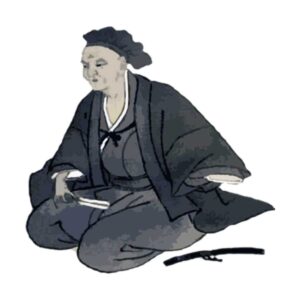
Founder of the tea ceremony, born in 1422 (Oei 29).
He is said to have called himself Dokushiken, Nansei, or separately as Korakuan Kyushinpōshi. His childhood name was Shigekichi. At the age of 11, he became a monk at Shomyoji Temple under Kofukuji Temple, but at around the age of 20, he drifted to various places, disliking ordination, and at around the age of 30, he became a Zen monk living at Shu-an Temple in Daitokuji Temple. His Zen master was the famous Zen master Ikkyu Sojun, who gave him the ink seki of enlightenment. Originally, Shuko was close to Noami, a friend of the Shogunate, and learned the tea ceremony of Shoin Taishi and the method of Chinese object recognition, but according to the “Yamakami Soujiki,” “Shuko is a monk of Shomyoji Temple in the southern capital. I will tell you everything I know about the tea ceremony and its oral traditions, as well as twenty-one articles. I will also tell you the details of the Buddhist teachings in the tea ceremony. In addition, he also explained the details of the Buddhist teachings in the tea ceremony. Shuko’s tea ceremony style was gradually deepening its spirituality, moving away from the traditional, superficial Shoin-style tea ceremony of decorating the tea room with Chinese objects, as is indicated in the following sentence given by Shuko to his disciple Harima Furuichi: “The most important thing in this way is to be careful about blurring the boundaries between the Japanese and Chinese traditions. It is important to be careful about this. It is outrageous for a novice to take a Bizen or Shigaraki object and have it be cold, and for a novice to be so cold that no one will forgive him. The Shugakuin-glazed ash-glazed melon body with bamboo ear is known as “the moon is not good when there are no clouds” (“Chugaku Dangi”), etc. The philosophy of Shuko in the tea ceremony was based on the traditional tea ceremony of the common people in the remote areas of the capital. He also added the Shoin-tea method he had learned from Noami, and here he renewed chanoyu as the Way of the Tea Ceremony. In this sense, Rikyu himself said, “I have learned the Dharma from Shaogaku, and I have learned the Way from Shukoh”, and Shukoh came to be called the founder of tea ceremony and the founder of the tea ceremony. He also recognized the deep and cool beauty of Shukoh celadon porcelain and ash-covered tenmoku, which had a strong inclination toward bitterness, as well as Korai tea bowls, which he treated like tenmoku, and discovered and adopted the beauty of Japanese ceramics such as Bizen and Shigaraki. He also possessed many Chinese objects, and among them, he bequeathed to his successor Soju his respect for works such as the Hengo ink painting, the Toutoukin tea caddy, and the Xu egret painting, as they symbolized the spirit of his sukkyoku. While living in Kyoto, he established a teahouse on the west side of the Rokujo Horikawa River, and it is said that Yoshimasa gave him the name “Shuko-an-shu” (master of Shuko-an). He had many disciples in Kyoto, Sakai, and Nara, including Matsumoto Shuho Mimi, Furuichi Sumitane, Awataguchi Zenpo, Torii Hidetoshi, etc. He died on May 15, 1502, at the age of 81.



